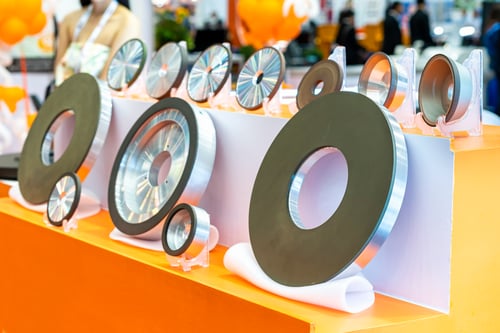Removing HVOF Coatings: Best Practices for Preserving Substrates
In the realm of surface engineering, High-Velocity Oxygen Fuel (HVOF) coatings stand out for their exceptional properties, such as high wear and corrosion resistance, essential in aerospace and industrial applications. However, the need to remove these durable coatings, particularly tungsten carbide and chromium carbide types, is a common challenge during equipment overhaul or re-coating processes. This detailed guide delves into the complexities of HVOF coating removal, focusing on methods like chemical stripping, grinding, and water jetting, and outlines best practices to ensure the preservation of the substrate while maintaining optimal surface finishes.

Understanding HVOF Coatings and Their Impact
HVOF thermal spray coatings are applied using a high-velocity oxygen fuel process, creating a dense, hard layer of materials such as tungsten carbide or chromium carbide on various substrates, including steel and stainless steel. These coatings are characterized by their low porosity, superior adhesion to the substrate, and exceptional performance in wear and corrosion resistance, especially under high-temperature conditions and in corrosive environments.
The hardness and thickness of HVOF coatings, typically much greater than traditional coatings like hard chrome plating, pose distinct challenges during removal. The thickness can vary significantly, often requiring different approaches for effective removal without damaging the substrate material. Additionally, the hardness of these coatings, coupled with their strong adhesion to the substrate, demands careful consideration of removal techniques to preserve the integrity and desired properties of the underlying material.
Comparative Analysis: Plasma Spray vs. HVOF
While both plasma spray and HVOF are thermal spray processes used in coating applications, they have distinct differences and are suited to different types of coatings and applications. Plasma spray operates at higher temperatures and is ideal for applying oxide coatings. It allows for a wider range of coating materials and is typically used for coatings that require a higher degree of porosity or specific electrical or thermal properties.
In contrast, HVOF utilizes a high-velocity jet to produce denser, harder coatings with better adhesion and lower porosity. These characteristics make HVOF coatings more suitable for applications that demand high wear resistance, such as in aerospace components and heavy industrial machinery. HVOF coatings are also known for their superior high-temperature performance and corrosion resistance, making them an excellent choice for harsh operational environments.
Comprehensive Overview of HVOF Coating Removal Techniques
- Chemical Stripping: This method employs strong chemical solutions to dissolve the coating material without damaging the substrate. It is particularly effective for removing certain types of coatings, such as chromium, and is favored for its minimal impact on the mechanical and structural integrity of the substrate. However, chemical stripping necessitates strict adherence to safety and environmental protocols due to the hazardous nature of the chemicals involved.
- Grinding with Diamond Wheels: The physical removal of coatings through abrasive grinding with diamond wheels is effective for harder, thicker coatings. Diamond wheels, unlike CBN, are better suited for the high hardness of HVOF coatings. This method offers control over the final surface finish but generates heat, possibly inducing residual stresses.
- Water Jetting: Water jetting is a non-destructive method that employs high-pressure water streams to erode the coating. This technique is particularly suitable for removing softer, more ductile coatings and ensures that the substrate remains unaffected. However, its effectiveness diminishes with harder or thicker coatings. Additionally, water jetting is advantageous in situations where heat-induced changes to the substrate material are a concern, as it generates no heat.
Best Practices for Safe and Effective Removal of HVOF Coatings
- Comprehensive Assessment: Before initiating the removal process, it is critical to conduct a thorough assessment of both the coating material and the substrate. Understanding the specific properties of the coating, such as its hardness, thickness, and adhesion to the substrate, is vital in selecting the most appropriate removal technique. Similarly, evaluating the substrate material, its mechanical properties, and any potential sensitivities to heat or mechanical stress is essential to prevent damage during the removal process.
- Heat Treatment Considerations: For substrates that are sensitive to thermal effects, such as certain alloys or stainless steel, careful consideration of pre- and post-removal heat treatments is necessary. These treatments can help mitigate any adverse effects of the removal process, such as thermal distortion or the induction of residual stresses.
- Safety and Environmental Compliance: Ensuring adherence to safety and environmental regulations is paramount, especially when dealing with hazardous materials like chromium in chemical stripping processes. Proper handling, containment, and disposal of hazardous materials are essential to protect workers and the environment.
![]()
Removing HVOF coatings is a complex task that requires a nuanced understanding of both the coatings and the substrates they are applied to. Whether through chemical stripping, grinding, or water jetting, each method has its unique advantages and challenges. The choice of technique should be tailored to the specific requirements of the application, considering factors such as coating thickness, substrate material, and the desired final surface finish. Employing these best practices not only ensures efficient and safe removal of hard coatings but also preserves the integrity and performance of the underlying substrate, which is crucial in high-stakes applications like aerospace and industrial machinery.
Recent Posts
Subscribe to email updates
Subscribe to our blog to get the latest updates from the experts on Grinding Wheels! You can easily unsubscribe at any time



